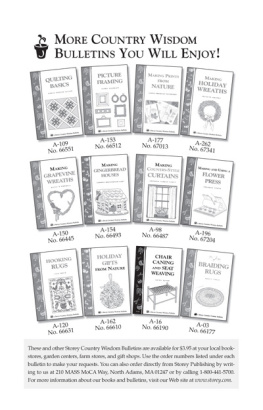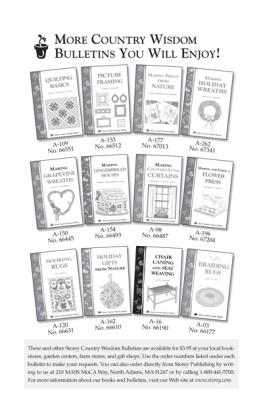THE KNITTING PROBLEM-SOLVER
TISH LILIE

The mission of Storey Publishing is to serve our customers by publishing practical information that encourages personal independence in harmony with the environment.
Edited by Cornelia Parkinson
Cover illustration by Brigita Fuhrmann
Cover design by Carol J. Jessop (Black Trout Design)
Text illustrations by Alison Kolesar
Text design and production by Nancy Bellnier
1991 by Storey Publishing, LLC
All rights reserved. No part of this bulletin may be reproduced without written permission from the publisher, except by a reviewer who may quote brief passages or reproduce illustrations in a review with appropriate credits; nor may any part of this bulletin be reproduced, stored in a retrieval system, or transmitted in any form or by any means electronic, mechanical, photocopying, recording, or other without written permission from the publisher.
The information in this bulletin is true and complete to the best of our knowledge. All recommendations are made without guarantee on the part of the author or Storey Publishing. The author and publisher disclaim any liability in connection with the use of this information. For additional information please contact Storey Publishing, 210 MASS MoCA Way, North Adams, MA 01247.
Storey books and bulletins are available for special premium and promotional uses and for customized editions. For further information, please call 1-800-793-9396.
Library of Congress Cataloging-in-Publication Data
Lilie, Tish, 1937
The knitting problem-solver / by Tish Lilie.
p. cm
ISBN 978-0-88266-696-9 (alk. paper)
1. Knitting. I. Title.
TT820.L64 1991
746.432dc20
91-20926
CIP
Introduction
If Madame Defarge were alive today she would be knitting designer sweaters instead of secret messages! Knitting has become popular and profitable. New yarns in dozens of colors and textures, and pattern styles that are updated throughout the year, are two reasons why learning to knit has become so fashionable. Knitting is relaxing, creative, and portable. It is also one of the best ways to obtain superior wearables, furnishings, and novelty items at low prices.
Knitting was once exclusively the domain of women; now men and children in increasing numbers are learning the craft. The New York Times published an article about a class of elementary school children from Connecticut who were knitting squares for a blanket made out of wool sheared from Russian sheep. The purpose? To help promote goodwill between Russia and the United States. Knitting is even being used for dtente!
The questions and answers produced in these pages are those most frequently asked by both beginning and more experienced knitters.
Anyone can learn how to knit. And for those of you who do knit and are never quite satisfied with the results of your projects, the following questions and answers should help to unravel the mysteries of knitting and enable you to enjoy the fruits of your labor.
Tish Lilie has given knitting classes and served as knitting advisor to several craft stores. Her column, Needlepoint, appeared in two newspapers.
I. Needles and Accessories
Q: I am a new knitter, and when I went to select knitting needles for my first project, I was terribly confused as to which ones to choose. Everybody I spoke to recommended a different kind. Are certain ones better than others?
A: There is a confusing variety of knitting needles available today. The most common ones are:
a. painted aluminum
b. coated aluminum
c. wood and bamboo wood
d. Balene (trademark of the Boye Needle Company)
For several years, painted aluminum needles were the most frequently used, but many knitters found them fairly heavy, and in most cases, the paint chipped off rather easily and the needles scratched. Coated aluminum needles were developed and those are more durable but still rather heavy. Wooden and bamboo needles have been perfected so that theyre smooth and lightweight, but for heavy projects, they can break. My personal favorites are the Balene needles. Made of a composite material that closely resembles whale-bone, they are light in weight, therefore easy on your hands, and very smooth to work with when knitting. Warning: Balene needles in smaller sizes have a tendency to snap. The company has been working on that problem, and now includes an instruction sheet on how to avoid breakage. Better yet, the needles come with a lifetime guarantee. If one breaks, return it to the company, and they will replace it free of charge. In the final analysis, choose the needles you are most comfortable using. If you can, try to borrow different ones to try out before purchasing your own.
Q: I know most needles come in 10" and 14" lengths. Is it more economical to buy the 14" needles for all my knitting so I dont have to switch to the longer needles when working on a large number of stitches?
A: While some knitters prefer to work with the longer needles exclusively, I always recommend the 10" needles. They are easier to control and dont protrude as much when you work. If you need a larger-size needle, you can always switch to a circular needle. Circular needles come in different lengths and have a flexible center. They can be used as regular needles as well as for knitting in the round, and take up much less space when working on projects that require a large number of stitches.
Q: Is it all right to switch needles in midstream, so to speak? In other words, if I lose a wood size 10 knitting needle while Im working on a project, can I use an aluminum size 10 as a substitute?
A: No. Although knitting needle sizes should be regulated, there is often a discernible difference in a given size from one type of needle to another, and from one company to another. If you test several different type needles in a given size with a needle measurer, you will see that difference. Switching needles, even if theyre marked the same size, might well change your stitch gauge. If you dont want to buy a new set of needles when you lose one midproject, test the substitute needle with a needle measurer and make sure its the exact same size.
Q: I have recently learned to knit and love it. Since I plan to continue knitting, is there a basic set of knitting accessories that I can purchase so that I dont have to run to my knitting shop every time I need a new gadget or needles?
A: Yes. Your basic knitting equipment should consist of the following items.
a. A soft tape measure. The retractable kind is best.
b. A 6" ruler. Preferably a sewing ruler.
c. Stitch markers. These usually come in assorted sizes in a small plastic box. The round markers are best for marking off sections of your work, and slipping them from needle to needle. The split markers are handy for marking knitted areas such as armhole edges, as theyre easily removed. I would suggest purchasing both kinds.
d. A set of crochet hooks, for picking up dropped stitches, weaving yarn ends into seams, and for finishing necklines and edges in patterns that call for crocheted finishing.
e. Cable needles. These now come in sets of three assorted sizes, and sets are more economical than purchasing them separately.
f. A package of assorted-size blunt-point tapestry needles




